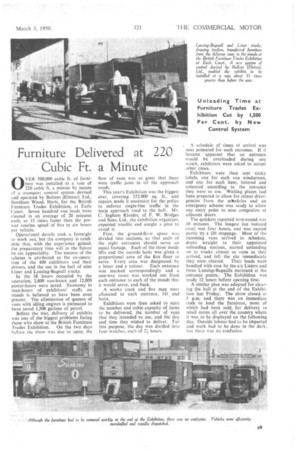Furniture Delivered at 220
Page 45

If you've noticed an error in this article please click here to report it so we can fix it.
Cubic Ft. a Minute
0 VER 500,000 cubic ft of furniture was installed at a rate of 220 cubic ft. a minute by means of a transport control system devised and operated by Buliens (Elstree). Ltd., Boreham Wood, Herts, for the British Furniture Trades Exhibition, at Earls Court. Seven hundred van loads were cleared in an average of 20 minutes each, or 15 times faster than the prewar routine speed of five to six hours per vehicle.
Operational -details took a fortnight to work out, but the company is confident that, with the experience gained, the preparatory time will in the future be cut appreciably. The success of the scheme is attributed to the co-operation of the 400 exhibitors and their drivers, and the use in the hall of nine Lister and Lansing-Bagnall trucks.
In the 38 hours occupied by the operation, 2,800 van-hours and 12,000 porter-hours were saved. Economy in man-hours of exhibitors' staffs on stands is believed to have been even greater. The elimination of queues of vans with idling engines is estimated to have saved 1,500 gallons of petrol.
Before the war, delivery of exhibits was one of the biggest problems facing those who show at the British Furniture ;Trades Exhibition. On the two days bzfore the show was due to open, the flow, of vans was so great that there were traffic jams in all the approach roads.
This year's Exhibition was the biggest ever, covering 252,000 sq. ft., and repairs made it necessary for the police to enforce single-line traffic in the main approach road to the hall. Mr. C. Inghatn Rhodes, of F. W. Bridges and Sons, Ltd., the exhibition organizer, expected trouble and sought a plan to avoid it.
First, the ground-floor space was divided into sections, so that each of the eight entrances should serve an equal footage. Each of the three inside lifts and the outside hoist was given a proportional area of the first floor to serve. Every area was designated by a letter and a colour. Each entrance was marked correspondingly and a one-way route was worked out from each entrance to each of the stands that it would serve, and back.
A works truck and five men were allocated to eachentrance, lift, and hoist.
Exhibitors were then asked to state the number and cubic capacity of items to be delivered, the number of vans that they intended to use, and the day and time they wished to deliver. For this purpose, the day was divided into four watches, each of 2l hours. A schedule of times of arrival was next prepared for each entrance. If it became apparent that an entrance would be overloaded during any watch, exhibitors were asked to accept other times.
Exhibitors were then sent sticky labels, one for each van windscreen, and one for each item, lettered and coloured according to the entrance they were to use. Waiting places had been prepared to allow for minor divergencies from the schedules and an emergency scheme was ready to allow any entry point to ease congestion at adjacent doors.
The quickest reported turn-round was 10 minutes. The longest (an isolated case) was four hours, and was caused partly by a lift stoppage. Most of the incoming vans arrived to schedule, drove straight to their appointed unloading stations, started unloading on to trucks almost as soon as they arrived, and kit the site immediately they were cleared. Their loads were handled with ease by the six Listers and three Lansing-Bagnalls stationed at the entrance points. The Exhibition was ready 12 hours before opening time.
A similar plan was adopted for clearing the hall at the end of the Exhibition last Friday. The show closed at 5 p.m. and there was an immediate rush to load the furniture, most of which had been sold, for delivery to retail stores all over the country where it was to be displayed on the following day. Outside labour had to be imported and work had to be done in the dark, hut there was no confusion.
































































































